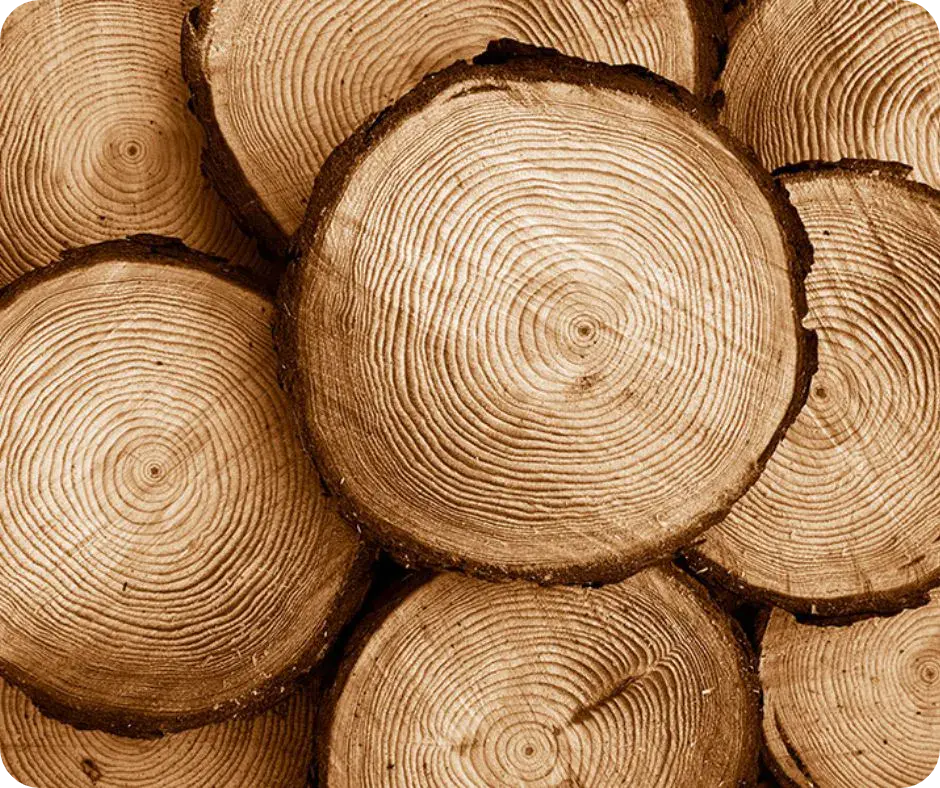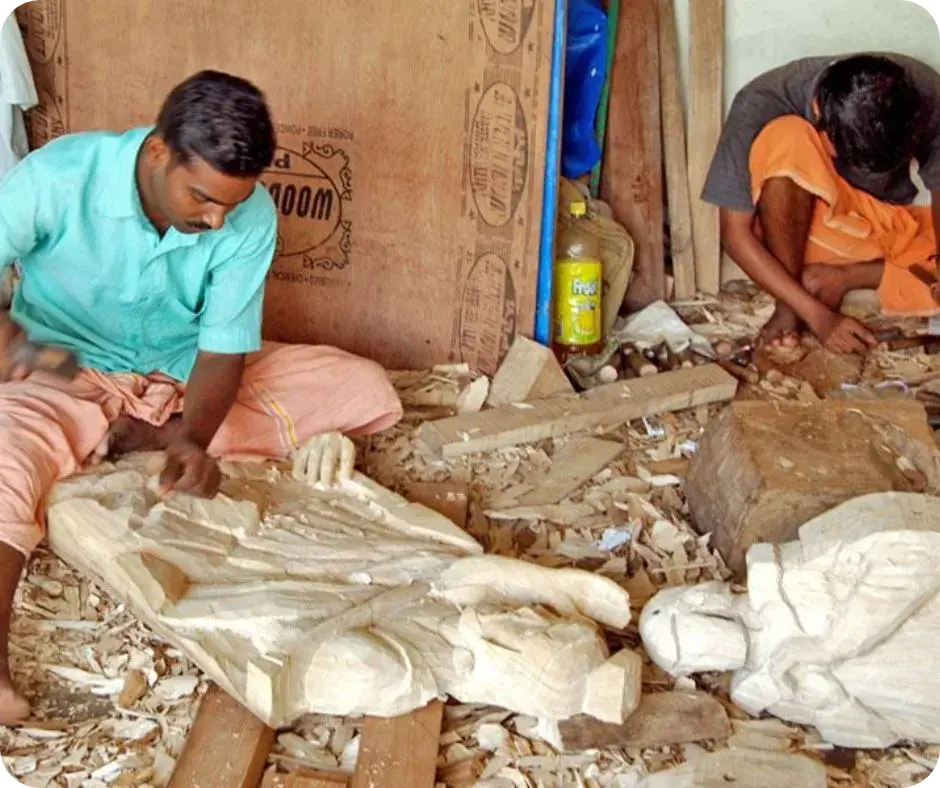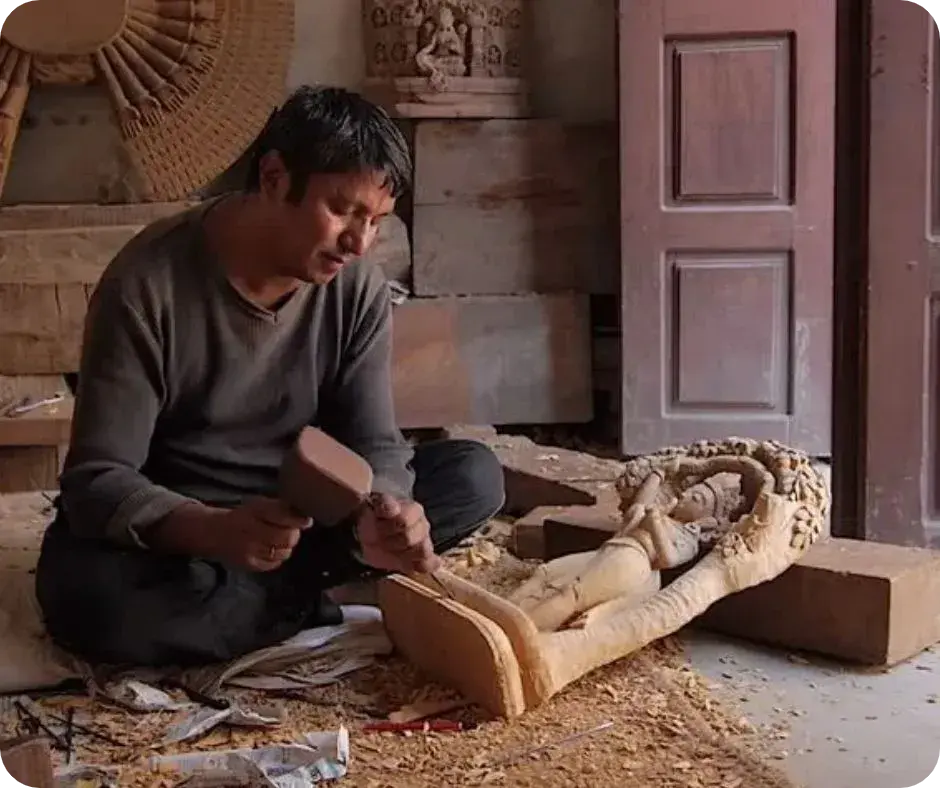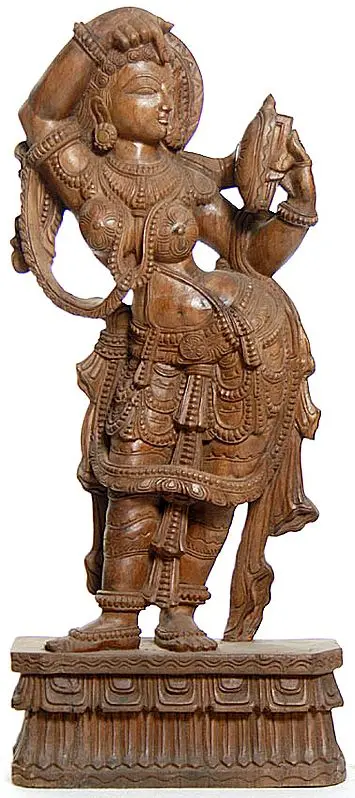Young Damsel Applying Vermilion on Her Hair-Parting (Based on Khajuraho)
| Specifications |
| RZ46 | |
|
South Indian Temple Wood Carving
| |
| Height: 34.8 inch | |
| Width: 13.5 inch | |
| Depth: 5.8 inch | |
| Weight: 10 kg |
| Delivery and Return Policies |
| Returns and Exchanges accepted with 7 days | |
| Free Delivery |
As such, a huge body of canonical literature with emphasis on one aspect or other emerged and classified woman as Nayika – heroines, the term used for ladies in love and with social distinctions, the theme of Indian classical literature since at least 500-400 B.C., under various types assessing the level of each one’s virtue and beauty and her love-life. This canonical literature saw in a woman’s loyalty her highest virtue and the relevance of her beauty and of adorning it. It is this model of beauty : the beauty coupled with virtue, that the wood-statue, as also its Khajuraho proto-type, represents. Identical representations of young ‘Nayikas’, though not with the same beauty of form, perfect modeling, plasticity and fluid anatomy as reveals Khajuraho Nayika, were rendered in abundance on many temple-walls to include Konark temple in Orissa and Bhoramadeva temple in Chhattisgarh illustrating Indian perception of a woman’s beauty.
A simple theme, the young lady of this wood statue is applying vermilion on her hair-parting while looking into a mirror as part of her make-up; the portrayal has, however, further dimensional breadth. It portrays the damsel’s beauty as also the lady endeavouring to enhance it but essentially subordinating it to virtue revealing in her loyalty. The young lady’s beauty, full of lustre and divine glow, reflecting in the mirror, seems to bewitch her and she is further making it up but all to please her lord she is wedded to, and as the symbol of this and of her dedication to him, as also to bar all other eyes to reach her, she is putting vermilion on her hair-parting. For portraying the divinity that her virtue imparts to her beauty the artist has sculpted a halo, the symbol of the divine aura, along her face. In classification of Nayikas, the faithful wife is classed as the highest of all.
The figure of the young lady has been installed on a beautifully sculpted lotus pedestal. Though at the cost of her height which in a curved figure appears to be far less, the artist has preferred dramatizing it by introducing curves first around the waist which projects her hips to left and bends her subdued belly, then around the shoulders throwing it to right giving sensuous projection to her breasts, and finally, tilting the head leftwards giving a unique profile to her entire being. The well-bejeweled damsel covered with lavish ornaments from head to feet : large ‘karna-phools’ – the flower-like conceived ear-ornaments, necklaces, arms-band, bangles, girdle, anklets, ornaments for feet among others, is the model of absolute beauty. The large size flowers like shaped stana-patta further magnifies the beauty of her sensuously modeled breasts. An elegantly pleated antariya, conceived like a tight-fitted pajama beautified by a decorative band in the parting of legs and a wide range of frills suspending from the girdle covering a large part of the antariya and a long gorgeous sash winding around her both arms, neck and unfurling on both sides afford great magnificence to her form.
This description by Prof. P.C. Jain and Dr. Daljeet. Prof. Jain specializes on the aesthetics of literature and is the author of numerous books on Indian art and culture. Dr. Daljeet is the curator of the Miniature Painting Gallery, National Museum, New Delhi. They have both collaborated together on a number of books.
 to all international destinations within 3 to 5 days, fully insured.
to all international destinations within 3 to 5 days, fully insured.Sculpting Serenity: Unveiling the Art of Crafting Wood Statues
1. Selecting the right wood
The process of wood carving begins with selecting a chunk of wood that is required according to the type and shape of the statue to be created by the sculptor. Both hardwoods and softwoods are used for making artistic pieces, however, hardwoods are preferred more than softer woods because of their durability and longevity. But if heavy detailing is to be done on the statue, wood with fine grain would be needed as it would be difficult to work with hardwood.
2. Shaping the wood
Once the wood type is selected, the wood carver begins the general shaping process using gouges of various sizes. A gouge is a tool having a curved cutting edge which is useful in removing large unwanted portions of wood easily without splitting the wood. The sculptor always carves the wood across the grain of the wood and not against it.
3. Adding detailing
When a refined shape of the statue is obtained, it is time for making details on the statue using different tools. This is achieved by using tools such as a veiner to make and a V-tool to create decorative and sharp cuts.
4. Surface finishing
Once finer details have been added, the sculptor is ready to smoothen the surface and give it a perfect finish. Tools such as rasps and rifflers are used to get a smooth surface. The finer polishing is obtained by rubbing the surface with sandpaper. If a textured surface is required, this step is skipped. Finally, to protect the statue from excessive dirt accumulation, the sculptor applies natural oils such as walnut or linseed oil all over it. This also brings a natural sheen to the statue.
How to care for Wood Statues?
Wood is extensively used in sculpting especially in countries like China, Germany, and Japan. One feature that makes the wood extremely suitable for making statues and sculptures is that it is light and can take very fine detail. It is easier for artists to work with wood than with other materials such as metal or stone. Both hardwoods, as well as softwood, are used for making sculptures. Wood is mainly used for indoor sculptures because it is not as durable as stone. Changes in weather cause wooden sculptures to split or be attacked by insects or fungus. The principal woods for making sculptures and statues are cedar, pine, walnut, oak, and mahogany. The most common technique that sculptors use to make sculptures out of wood is carving with a chisel and a mallet. Since wooden statues are prone to damage, fire, and rot, they require proper care and maintenance.
- Wood tends to expand and contract even after it has been processed, thus it is always recommended to keep the wooden sculptures in rooms with little humidity. Excess moisture can harm your masterpiece.
- Periodical dusting of the finished piece is necessary to maintain its beauty as dust accumulation on the surface takes away the shine of the sculpture. You can use a clean and soft cloth or a hairbrush for this purpose.
- You must avoid applying any chemical-based solutions that may damage the wood from the inside. Instead, you can apply lemon oil or coconut oil using a cotton rag to the sculpture to bring out its natural shine. Lemon oil also helps to clean any stains on the sculpture.
- Applying a layer of beeswax protects the wood from sun damage and hides even the smallest imperfections on the wood.
It is extremely important to preserve and protect wooden sculptures with proper care. A little carelessness and negligence can lead to their decay, resulting in losing all their beauty and strength. Therefore, a regular clean-up of the sculptures is a must to prolong their age and to maintain their shine and luster.



